This is a Canon AV-1 35mm SLR camera which was the fourth in the family of Canon A-series film SLRs released in the late 1970s. The A-series was one of the most popular line of cameras in the world and helped cement Canon as one of the top camera makers in the world. The AV-1 was created to satisfy demand in the United States and other export countries for an aperture priority camera to compete with models being released by Nikon, Olympus, and Minolta. Although it was not the most successful in the line, it is still an excellent camera that stands the test of time along it’s much more popular brother, the AE-1.
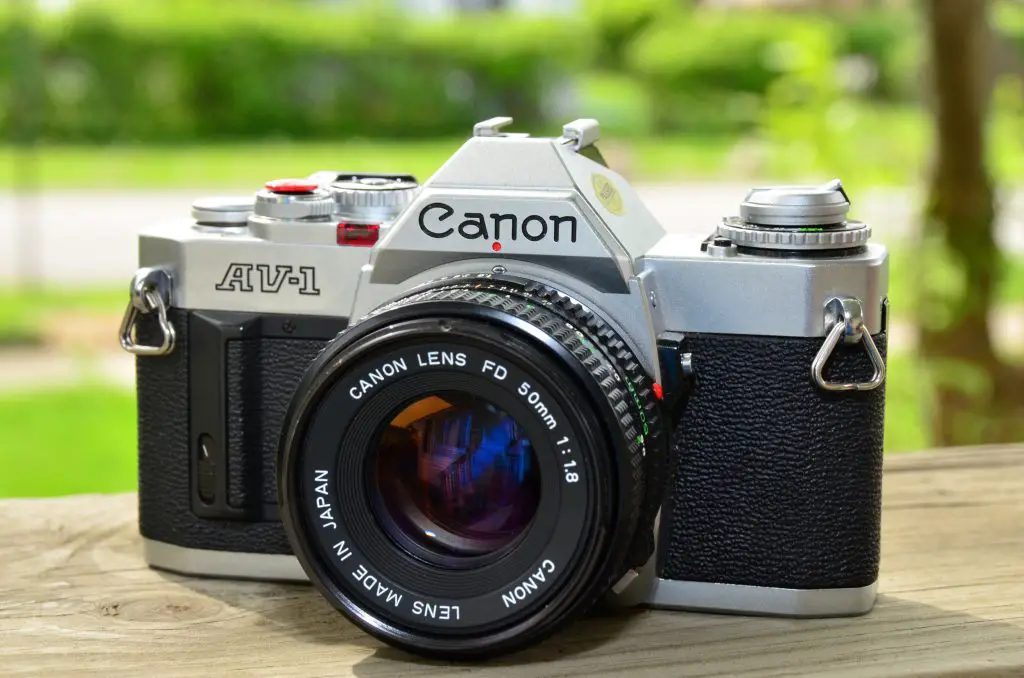 Film Type: 135 (35mm)
Film Type: 135 (35mm)
Lens Mount: Canon FD Breech / Bayonet Mount
Lenses: 50mm f/1.8 and 28mm f/2.8 Canon FD and Vivitar 28 – 135 mm zoom lens
Focus: Fixed SLR Prism
Shutter: Focal Plane Cloth
Speeds: B, 2 – 1/1000 seconds
Exposure Meter: TTL Center Weighted CdS meter with LED Viewfinder Readout
Battery: 6v Silver Oxide or Lithium PX28 or 544 Battery
Flash Mount: Hotshoe
Manual: http://www.cameramanuals.org/canon_pdf/canon_av-1.pdf
History
Today, Canon is one of the largest electronics companies in the world. It is the 10th largest company in Japan and is a primary member of the Japanese stock exchange. Most everyone on the planet has at one time in their lives used or touched a Canon product, whether it was a camera, scanner, copier, or printer. Despite their massive success today, Canon was a relative late comer to the Japanese camera industry in the first half of the 20th century.
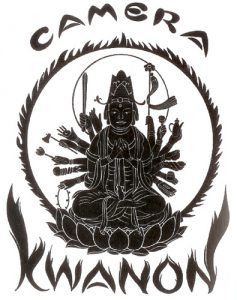
Canon was founded in 1933 as Seiki Kogaku K.K. or Precision Optical Industries in English by a modest repair technician named Goro Yoshida, Yoshida’s brother-in-law Saburo Uchida, and a third man named Takeo Maeda with a goal of building Japan’s first compact 35mm camera. Their first prototype was called the Kwanon, named after the Buddhist Goddess of Mercy. It was heavily inspired by the Leitz Leica II rangefinder.
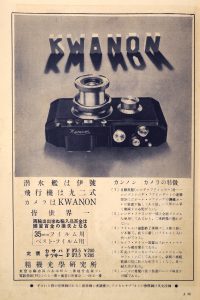
The Kwanon was shown in wooden and illustration form in various Japanese publications at the time, but according to Canon Global’s company history page, none were known to actually have been built. Goro Yoshida had at one time claimed to have built 10 Kwanon models, but this information has been doubted as none have ever been seen. There is at least one camera called a Kwanon Model D that is often cited as a real Kwanon, but it was later found to be a rebadged Leica II that was not actually built by Seiki Kogaku. Most online sources with information about the Kwanon camera, show this same Kwanon Model D.
Although Seiki Kogaku had the necessary technology and expertise to design the body and shutter to German specifications, they lacked the expertise in optics design, they had to call upon the expertise of another Japanese optics company called Nippon Kogaku. Nippon Kogaku had been around since 1917 and built many optics products for the Japanese military. After World War II, Nippon Kogku would design their first camera called the Nikon. Nippon Kogaku would later become one of Seiki Kogaku’s biggest competitors, but they started out as partners.
The Kwanon was never sold to the public, and by the time it was ready for civilian consumption in 1936, it’s name had changed to the Hansa (or Standard) Canon. In manufacturing the Hansa Canon, Seiki Kogaku was responsible for the main body including the focal-plane-shutter, the rangefinder cover, and the assembly of the camera body, and Nippon Kogaku was responsible for the lens, the lens mount, the optical system of viewfinder and the rangefinder mechanism.
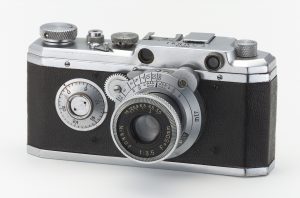
In the early 1940s the company made a variety of optical products such as X-ray lenses and lenses for television cameras. By the end of World War II, Seiki Kogaku changed it’s name to Canon Camera Co., Inc which was in line with other Japanese companies who adopted more English sounding names in an effort to appeal to Western countries who were reluctant to purchase goods made by Japanese companies.
With it’s beginnings making copies of Leica inspired rangefinders, Canon continued their focus on rangefinders into the 1950s. Although originally considered a clone of the Leica, Canon rangefinders adopted more and more proprietary features differentiating them from their German competitors. Starting with the Canon VI in 1956, the Canon P in 1959 and the Canon 7 series in 1961, Canon’s reputation as a world class maker of top of the line rangefinder cameras became undisputed. While the Germans were still considered the best, they no longer stood alone, and Canon rangefinders could compete head to head with the German models.
By the mid 50s, more and more Japanese companies were turning their attention to SLR cameras which at that time were exclusively made by German companies. The first Japanese SLRs were made by Asahi (Pentax), Orion (Miranda), and Topcon. Both Nikon and Canon were relatively late to the Japanese SLR market, and both released their first SLRs in 1959. Unlike Nikon however, Canon would continue making rangefinders and SLR cameras side by side throughout the 1960s and 70s whereas Nikon pretty much shifted all of it’s focus to the SLR design and stopped making rangefinders in the early 1960s.
The earliest Canon SLRs were known as the Canonflex and it’s associated variants are now know as the Canon R-Series. These early SLR cameras lacked most modern features and had rudimentary designs. Although collectible by film historians, they aren’t sought after for their performance.
In 1964, Canon released a new line of SLRs that incorporated Through the Lens (or TTL for short) metering. This new line of cameras also introduced a new lens mount known as the FL mount. This new mount would set the groundwork for future Canon lens mounts for the next couple of decades.
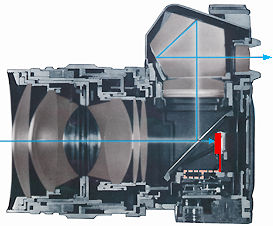
In 1965, the Pellix camera was introduced which attempted to solve one of the early challenges of TTL metering by incorporating a fixed semi-transparent mirror that allowed some of the light to pass through to the film plane, while redirecting the rest of the light up into the viewfinder. During exposure metering, a movable CdS sensor (represented in red in the image to the left) would swing up in front of the film plane for metering, and then swing back down when capturing an image.
Although the Pellix design did work, it came at the expense of viewfinder brightness. These Pellix cameras have very dark viewfinders since only some of the light is reflected by the mirror, which made them very difficult to shoot with in low light, plus the lack of a moving mirror made little to no improvements on quieting the sound of the camera compared to other SLRs of the day.
Only a year after the Pellix was released, Canon released the FT which was their first true success with a 35mm SLR. The FT camera had a normal quick return mirror like most other SLRs, and had a large metal design body with a reliable shutter. The excellent build quality of the FT cameras and their growing reputation as an innovative company who made excellent lenses catapulted them near the top of the industry. The FT would be revised over the next few years as the FT QL, FX, FP, FTb, and FTbn.
By the end of the 1960s, rangefinder cameras were losing popularity with serious photographers and sales became more popular with casual or amateur photographers. The pros were shifting almost exclusively to SLRs and at this time the only player in the high end SLR market was Nikon with their F-series. In 1971, Canon released their F-1 camera which was based off the FT, but had a selection of interchangeable parts, accessories, and lenses. The F-1 introduced a new lens mount known as the FD. The new FD mount allowed for open aperture metering (as opposed to stop down metering like on the FL mount) and was backwards compatible with older lenses.
The F-1 was an immediate success and in some ways was the nail in the coffin for Canon’s rangefinder business. Although the company was still making entry level Canonet rangefinders, the company began their shift towards an SLR exclusive camera company.
In the mid 1970s, Canon was enjoying a lot of success with their pro and advanced amateur level cameras like the F-1, FTb, and EF. All of these models were well built, solid metal, high quality cameras with state of the art (for the time) features, and excellent build quality. However, around this time the market for smaller, lighter weight “compact” SLRs was heating up with the success of cameras like the Olympus OM-1 and Asahi Pentax Spotmatic. It was time for Canon to take a step into this market and release it’s own line of compact SLRs.
Canon could have probably just released an all mechanical camera with some type of exposure meter in a smaller chassis and called it a day, and it probably would have sold well. Rather than take the easy approach, they decided to go all out and completely design an all new chassis from the ground up with an industry first CPU controlled electronic shutter and full shutter priority auto exposure mode. Canon chose shutter priority over aperture priority because they felt that the amateur photographer would have an easier time understanding the concept of shutter speeds, as opposed to the f-stop system of aperture sizes.
The new camera was called the AE-1 and it would have a light weight body made of ABS plastic that Canon creatively disguised to look like metal. The AE-1 was chock full of electronics which limited the amount of mechanical parts making the camera both smaller, and lighter weight.
The AE-1 would use Canon’s breech lock FD lens mount first introduced in 1971 with the F-1, so it would already have an abundance of lenses to choose from. The breech lock system differed from a traditional bayonet or screw mount in that the mounting surface of the camera and lenses did not move during the installation of the lens. A photographer would align dots on the body of the camera and the lens, and then turn a metal ring which would secure the lens to the body. By not having any movement between the mounting surface of the lens and camera, there was no chance that it could wear away over time.
The AE-1 was a huge success as over a million were sold all over the world between 1976 and 1984. Although other models would follow in the A-series line, the AE-1 and it’s replacement, the AE-1 Program are still one of the best selling Canon film cameras of all time.
To build upon the success of the AE-1, Canon expanded the A-series line, and each of the next few years a new model was released. First, was the AT-1 in 1977 which was an AE-1 with a match needle manual exposure mode, and then the top of the line A-1 from 1978 which was Canon’s first model with both aperture and shutter priority modes.

Despite the success of the AE-1, there was a huge demand, especially in the United States, for an Aperture Priority model to compete with models from Nikon and other companies who mostly had Aperture Priority only models. In 1979, the AV-1 was released which allowed users to manually select the aperture size on the lens and then the camera would select the shutter speed using the same CPU controlled exposure measurement system as the AE-1. Although still considered to be part of the A-series line, the AV-1 had an improved battery compartment that was easier to open and less likely to break and a slightly shorter body that weighed less (512 grams body only vs 590 grams body only for the AE-1).
The AV-1 is a bit of an odd-duck in the Canon line as it was one of the very few cameras that offered an aperture priority mode. This model was also limited to only one manually selected shutter speed (1/60 seconds) and bulb mode, so the camera was not capable of full manual mode like every other model in the A-series line.
The AV-1 was marketed as an entry level camera that came in a kit with a 50mm f/2 lens and sold in 1979 for around $150 (about $480 in 2015 dollars). This was considerably cheaper than the AE-1 which sold new in 1976 for $210 (about $680 in 2015 dollars) and came with a faster 50mm lens.
Despite these differences, the AV-1 is compatible with every single lens and accessory that was available for the rest of the A-series line. The shutter, meter, and all internal electronics were exactly the same as in the AE-1, and as such was capable of the same quality shots.
Today, when most people think of an A-series Canon SLR, the AV-1 is usually not the first, second, or even third model most people think of. I could not find any information about production numbers of this camera, but considering the AE-1 reportedly sold in excess of 1 million cameras, I suspect that the AV-1 sold a small fraction of that amount. This can work for and against someone looking to pick one up today. On one hand, since the AE-1 is the most notorious model, many people specifically target that model when searching for a camera of this type. Not many people these days know about the AV-1 and it is rarely recommended as a popular model among vintage film shooters. In Ken Rockwell’s review of the AV-1 in 2005, he specifically tells his readers to skip this model because of it’s lack of an exposure lock or any way to make manual exposure correction. He also derides the camera for it’s limit of a 2 second shutter speed, unless you use Bulb mode.
Personally, neither of these limitations are a problem for me. I mostly use old cameras in moderate to well lit conditions and there’s almost no chance I’d ever need more than a 2 second shutter speed. Even with my DSLRs, I rarely approach 1 second shutter times.
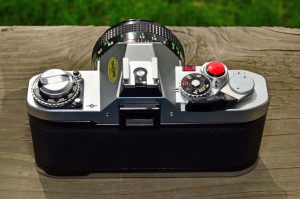
My Thoughts
I bought this AV-1 from KEH in one of their “As-Is” sales. I think I paid $7 for the body and probably another $7 for the lens. At the same time, I picked up an AE-1 and an AT-1. All 3 worked, but the AT-1 was in the roughest shape. I sold it on eBay with a cheap off-brand lens for $35. The amount of money I made from the sale of the AT-1 basically meant I broke even with the AE-1 and AV-1.
The AE-1 was in pretty good shape, but needed new light seals. The AV-1 however, was in near mint condition. The camera looked immaculate. I wonder why KEH graded this in their “As Is” category because they could have easily sold it for much more. My AV-1 was in such good shape, I never even bothered to change the light seals. I probably should, but as they are now, they are not crumbling or gooey. Even the viewfinder is completely free of particles.
I kept the AE-1 and replaced the light seals, but haven’t used it yet. I probably will one day, but I doubt I’ll write a full review of it. Pretty much everything about that camera would be so similar to this AV-1, and since it is such a common model, I don’t know that I could type up enough useful info that’s not already well known by everyone to make it worthwhile.
Along with my Minolta XG7, I never intended on getting this camera, but once I saw it was in such good shape, and the fact that I actually feel more comfortable in aperture priority mode, I threw in a roll of film and went shooting.
My Results
One of the things that I think gets lost when using a camera like this is how incredibly simple it is to use. Despite it lacking modern features like auto focus and full Program modes, you really have to try to not get a good picture out of this camera.
During my first two test rolls, I used the camera in a variety of lighting circumstances, indoors, outdoors, closeup, far away, etc. I even used all 3 lenses that I have for this camera. I have both Canon FD 28mm and 50mm lenses, but I also have a Vivitar 28-135mm zoom lens. The Vivitar is another KEH “As Is” acquisition. I think I paid $9 for the lens and it was in great condition. In the digital world, I shoot Nikon DSLRs, and I had some bad experiences with third party lenses, so I had typically held the belief to sticking with matching brand lenses and cameras. I had never tried a Vivitar lens, but considering the cheap price, I gave it a shot and I have to say I am impressed. The lens is heavy and feels very solid in your hands. Despite it having a maximum aperture of “only” f/3.5, it is not hard to manually focus thanks to the AV-1s bright viewfinder.
The Vivitar is also capable of Macro shots by rotating an extra grip on the barrel of the lens. Although I didn’t play too much with Macro shots, it seemed to work very well, and allowed me to focus as close as 12 inches away. Upon review of the shots I took with the Vivitar, I did notice that it lacks some of the sharpness of either the 28mm or 50mm Canon lenses, but I think that is expected of any zoom lens, especially one from the late 1970s – early 1980s.
Despite the flexibility a range of 28mm to 135mm gives you with a single lens, if ultimate sharpness is what you are after, you should stick with one of the fixed focus lenses like the Canon 28mm or 50mm primes. Even now, in 2015 fixed focal length lenses are capable of sharpness levels that most zoom lenses can’t match, but 30 years ago the issue was more obvious. Serious photographers of the era shied away from zoom lenses preferring the superior optics of primes. Thats not to say you should avoid zoom lenses altogether, because they do offer a level of flexibility a fixed focal length lens can’t match, but you just need to be aware of the pros and cons of each.
Regardless of lens attached, the AV-1 is a joy to use. As I mentioned earlier, this is an aperture priority only camera, there are no manual settings allowed. If you can get over that hurdle, I think most photographers revisiting film SLRs would appreciate the light weight and compact size of this camera. It is easy to hold and carry, and it came at a time where the ergonomics of a typical camera were already well established. All of the controls are exactly where you expect them to be.
The metering system on this camera is top notch and every bit as accurate as those found on the more desirable A-series Canons. Attach any number of excellent Canon FD mount lenses, load in a 6v battery, and go out shooting. This camera is a precision tool that offers a photographer everything they need to get great shots every time time, without having features that get in the way.
Additional Resources
http://en.wikipedia.org/wiki/Canon_AV-1
http://www.kenrockwell.com/canon/av1.htm
http://quirkyguywithacamera.blogspot.com/2017/04/no-not-that-canon-oft-overlooked-av1.html
http://mir.com.my/rb/photography/companies/canon/fdresources/SLRs/av1/index.htm
http://camerapedia.wikia.com/wiki/Canon_AV-1
http://www.canon.com/camera-museum/camera/film/data/1976-1985/1979_av1.html

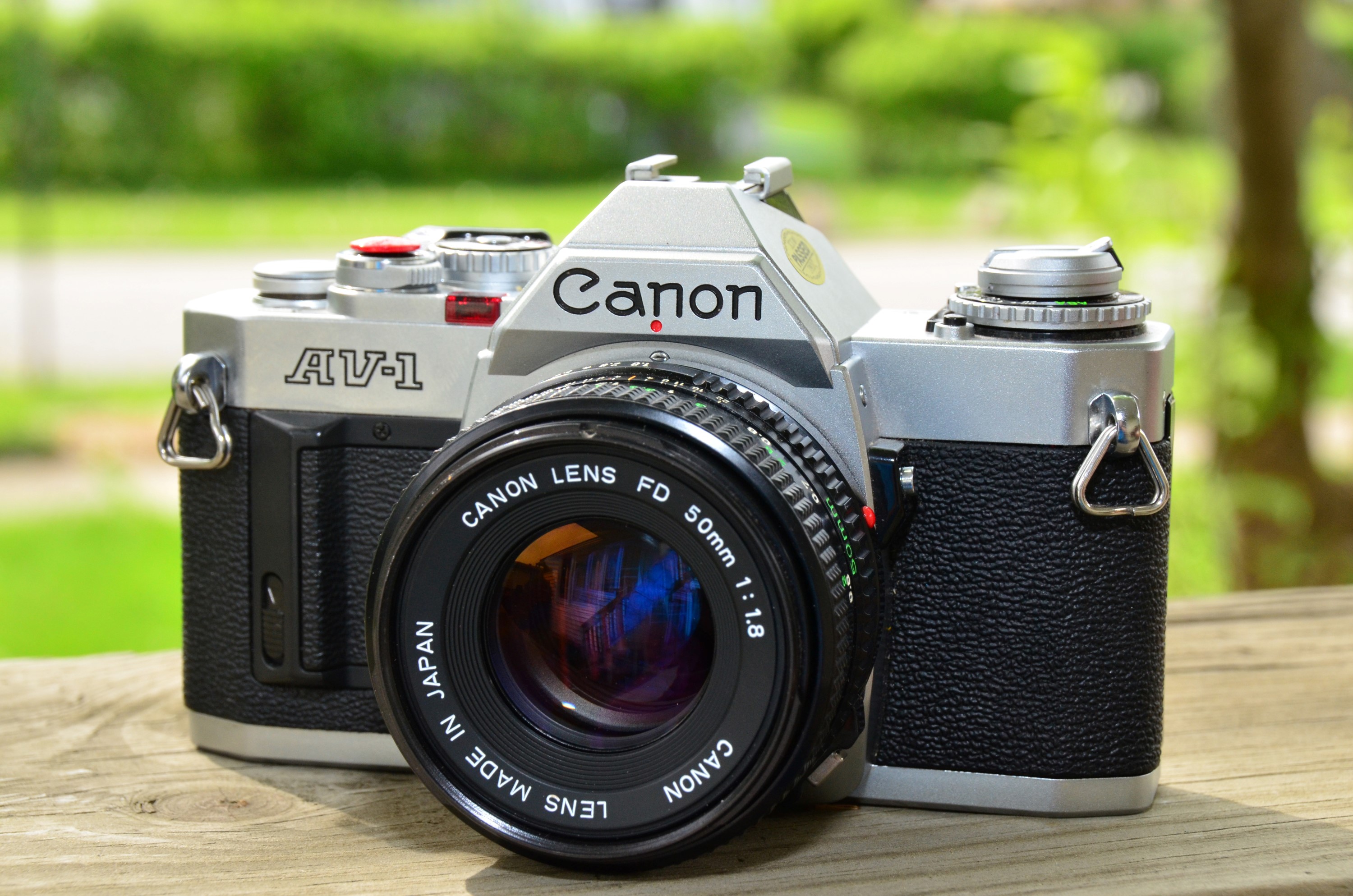
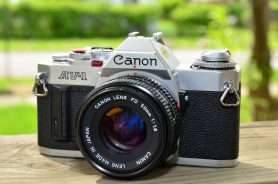











What a wonderful, complete, article to read, regarding this little gem of a camera.
I bought a used one 6 years ago to start in more “serious” photography, and it teached me a lot – the Iso button, for one, sees frequent use as a cheat to change exposure time.
Prefer this gem against an EOS any day of the week, just set aperture, compose and shoot. Who needs to waste time with dials?
Great review,
The AV1 was my first camera back in 1981
I fell in love with it then and still use it to this very day with a ssc 50mm 1.4 and a 24 mm 2.8 they still give me stunning photos, if anyone of a younger age wants to start shooting film don’t be put off by negative reviews please try an AV1 you will not be disappointed
Very interesting. I recent found a grubby AV-1 with the standard 50mm f1.8 lens for $5 in a junk box at a flea-market. I didn’t really need another FD body, but it looked so forlorn that I couldn’t leave it behind. I put a battery in it and, sure enough, it worked perfectly, without even the shutter-squeal of my AE-1P. After some cleaning it looks pretty nice, too. I like it a lot, it’s a fun camera that feels good in the hand.
The AV-1 was actually the 4th A series camera. AE-1 and AT-1 in ’76, A-1 in ’78, and AV-1 in ’79. The AE-1 Program and AL-1 came in the early 80s. You get it right in the body of the story, it’s just the intro that has it wrong.
Great article. I like how you dive into the history.
Thanks for bringing this to my attention! I have corrected it to say fourth in the intro! 🙂